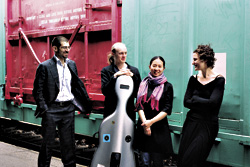Whenever the future of classical music is discussed, on blogs or in print, you won’t be far from complaints about the concert experience and the traditions of audience protocol. The words “suffocating” and “oppressive” are likely to crop up, and the conclusion drawn is that the formality, pretentiousness, and oppressiveness of expected concertgoing etiquette is turning off the potential new audiences necessary to keep the classical world from collapse.
A couple of things puzzle me. First, the classical concert experience is, in all essentials, identical to that of dance, theater, literary events, or for that matter—barring the munching of popcorn and cheering the fireball deaths of villains—movies. Go to the performance space, buy a ticket, sit down in rows, watch and listen, try not to disturb your fellow audience members. Yet it’s only in conjunction with concerts that you hear complaints about what a crushing burden this all is. Second, why is sitting quietly considered such an unendurable ordeal? Millions of people do it every night in front of their televisions.
But a number of classical musicians in Seattle and elsewhere are playing in untraditional venues—bars, coffeehouses, rock clubs—to give listeners an alternative, more intimate way to enjoy music. The Chiara String Quartet recently offered a near-ideal test case for audience behavior, playing Meany Hall on Nov. 27 and the Tractor Tavern on the 28th.
At Meany, Bartók’s Quartet No. 2 anchored a program of pieces that drew on folk idioms: Gabriela Lena Frank’s beguiling Leyendas inventively translated for strings the sounds of native Andean winds and percussion (while also suggesting pop styles and even electronic effects). Against a background of silence, Zhou Long’s Song of the Ch’in presented washes and wisps of sound as elegant and delicate as black-ink brush strokes on white paper. The Chiara’s Tractor concert included bits of the Meany program, older works (Haydn, Brahms), a quartet written for them by Jefferson Friedman, and an arrangement of Prince’s “Let’s Go Crazy” complete with the opening narration—which, oddly, came off as the evening’s least-fresh piece. After all, it’s been 21 years since the Kronos Quartet released a CD with “Purple Haze” on it, and the chamber-rock shtick is starting to get stale: always the same squealing and scrubbing and imitations of fuzzy electric guitars. (True, string instruments do this sort of thing pretty well, but if a quartet really wanted to push into new territory, it would try, say, a piece of clean, crisp ’80s electronic dance pop.)
The audience, as it happened, behaved exactly the same at both shows; no one took advantage of the Tractor’s informality to yak during the music or two-step in the aisles or do any of the things they’d have done at Meany if only they hadn’t been cruelly prevented by the cold rigidity of concert-hall protocol. In both venues people paid to hear music, and they sat and heard music. As for the fraught question of applauding between movements (which has long since overtaken tonality vs. atonality as classical music’s most tiresome argument), cellist Greg Beaver mentioned at the outset that at the Tractor we were allowed to clap whenever we wanted. He reminded us when no applause greeted the first movement of Friedman’s quartet—less because we were stifled by tradition, I think, than because of the way the movement ended: loud, fast, and abruptly. There we were, enjoying the powerful effect of the sudden silence, when we were essentially asked to spoil the mood and made to feel awkward and uncomfortable. Funny how these things work out sometimes.
While we’re refuting conventional wisdom, let’s also note that the cliché of old people being too conservative to tolerate new music seemed not to be in effect at Meany: There looked to be just as much white hair there as at any Seattle Symphony Mozart matinee, and as far as I could tell, they were digging it—the fidgetless focus of the thoroughly absorbed. (The attendance, if you were wondering: “703 tickets, or 58 percent full, which is in the ballpark of what we expect to do for a chamber concert when the group is unfamiliar to Seattle audiences,” reports Meany’s Gretchen Douma. The Tractor recital drew about 40 to 50 people.)
So what have we learned? Well, maybe people behave the way they do at concerts not because it’s an artificial standard imposed by ironclad tradition but because the music sounds better that way. Maybe listeners feel classical music most deeply when they pay quiet attention to it. Maybe sometimes not clapping is OK, and we don’t need to rush in and obliterate every silence. Maybe true innovations in concert presentation—new ways of getting music and music lovers together—will be concerned not with questions of formal vs. informal, loose vs. uptight, but with what setting best allows music to work its magic.
The concert experience as we know it could stand some fine-tuning—I don’t mind hearing musicians talk to the audience, and I’ll be the first to cheer when the tuxedo finally dies—but it’s evolved into a simple, commonsense, even efficient format for the communal experience of art, whatever hall you’re in. What’s the problem?







